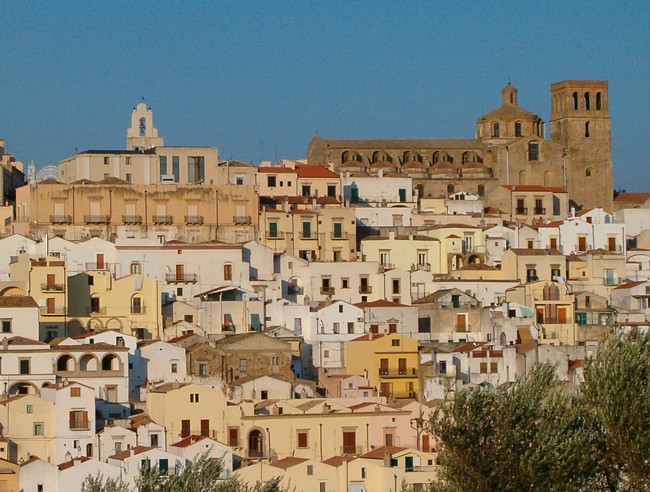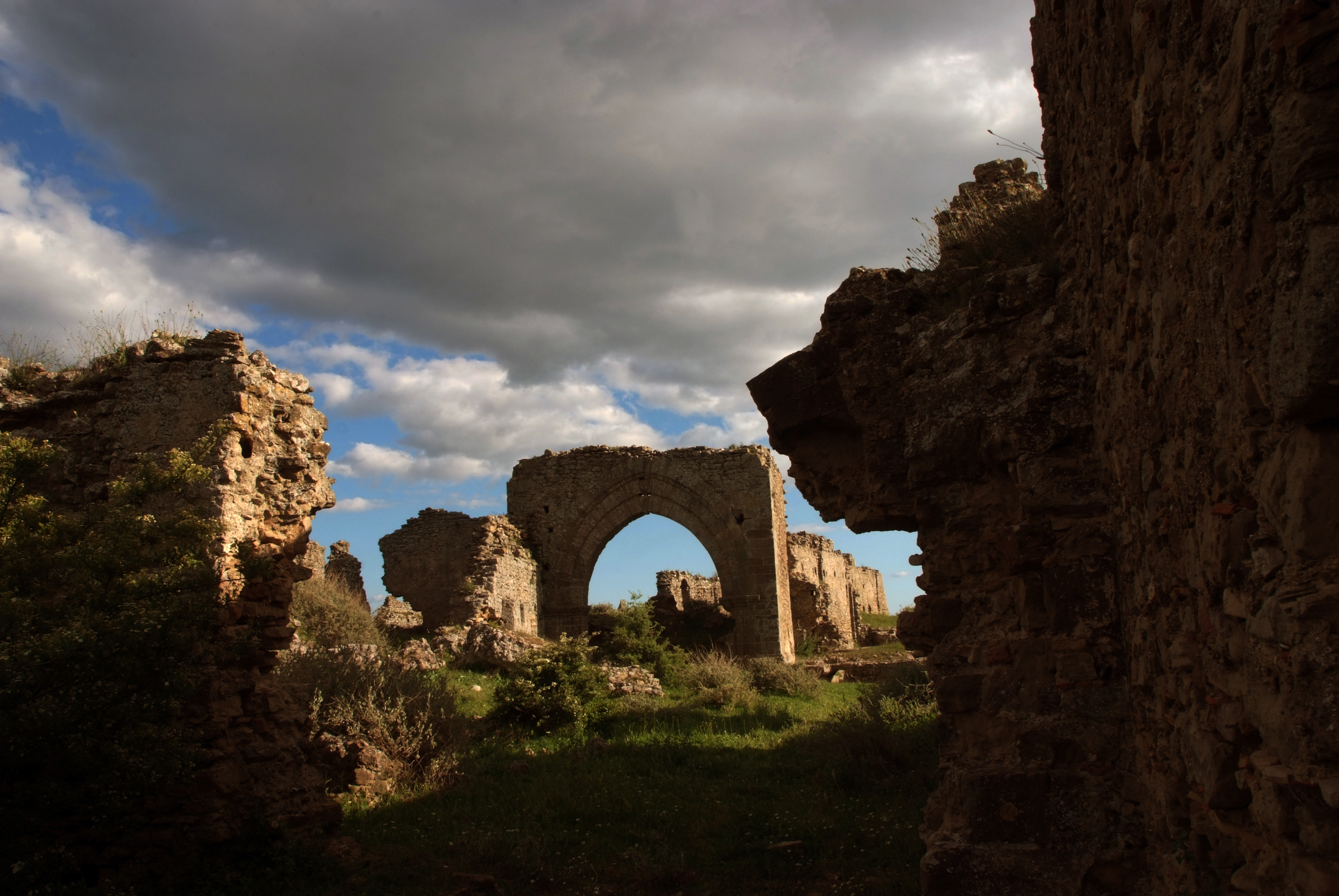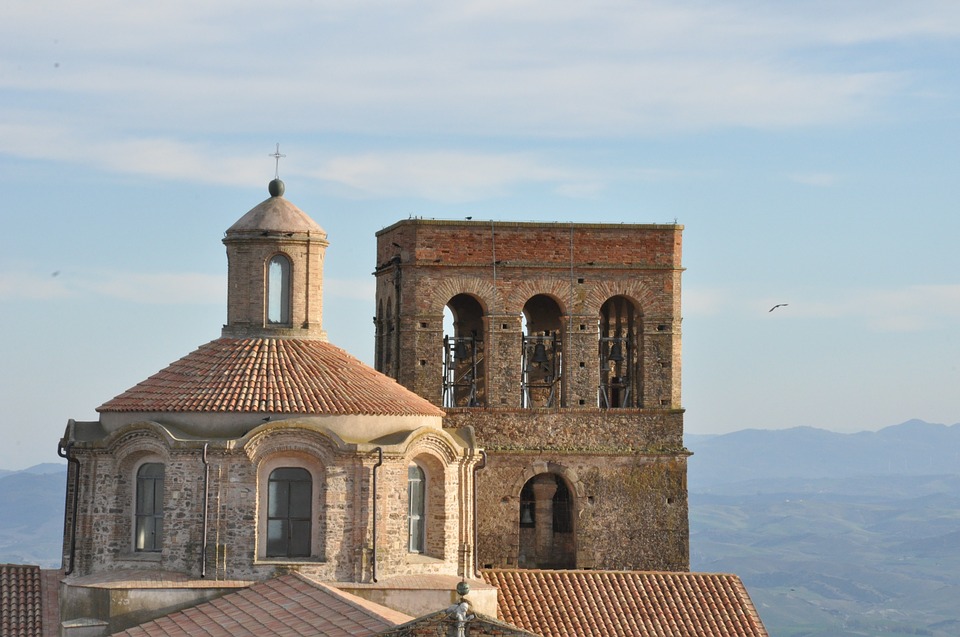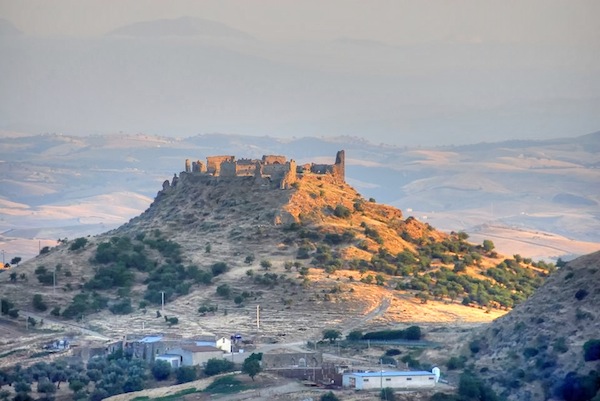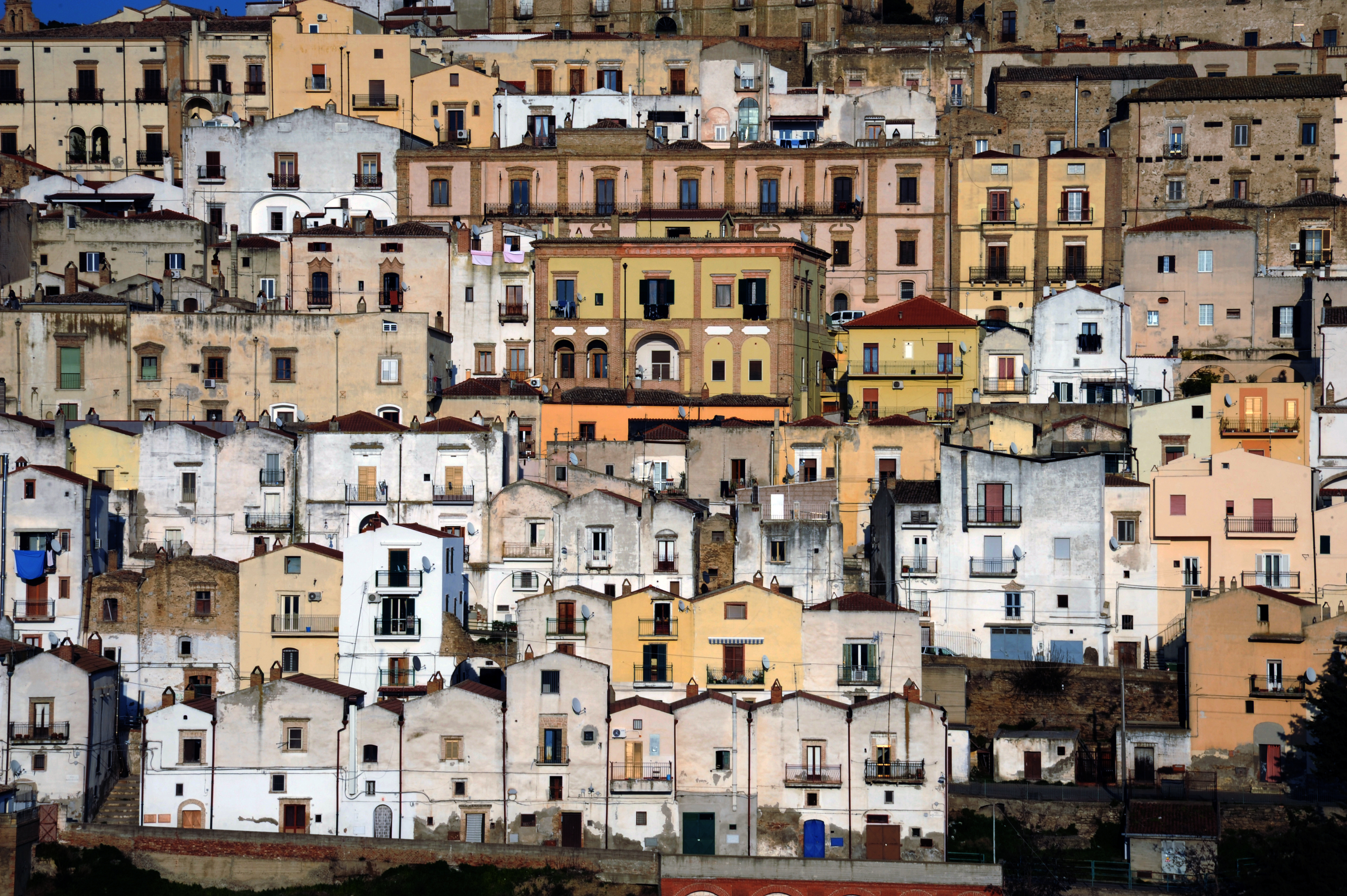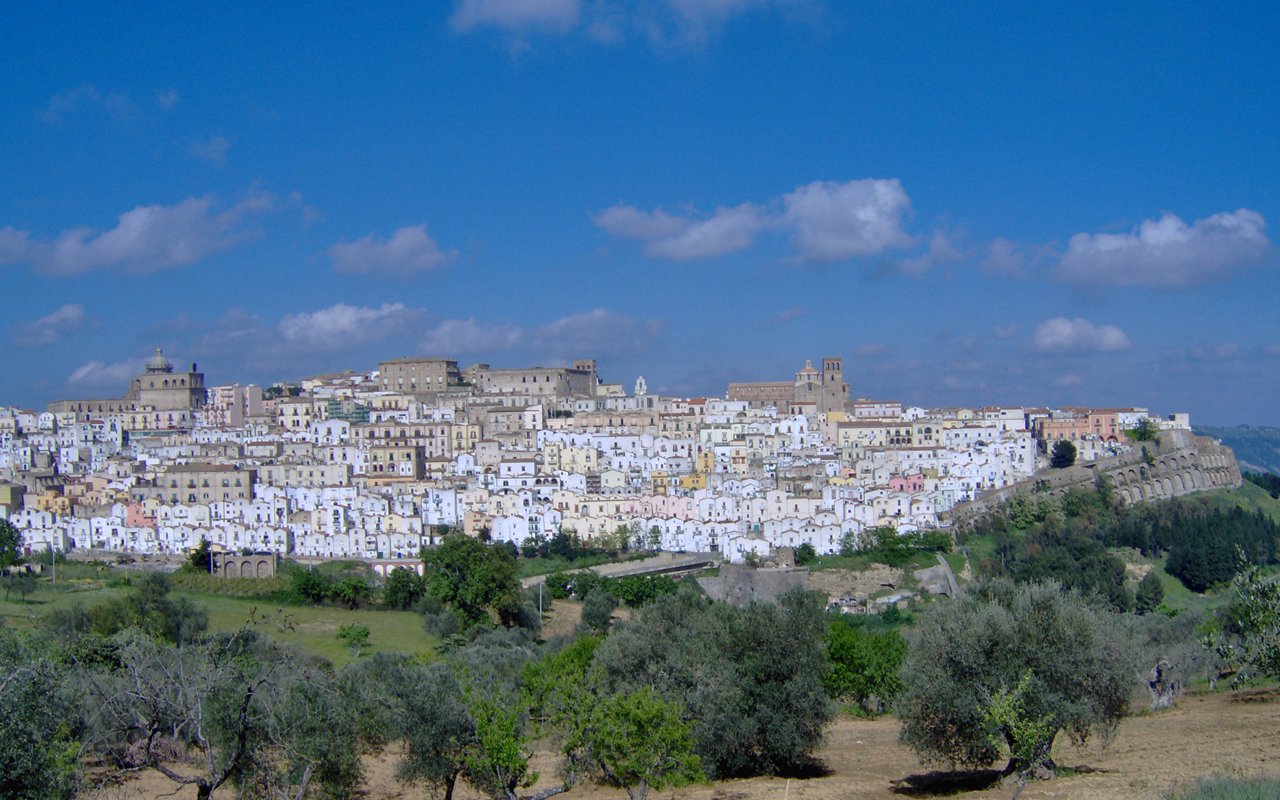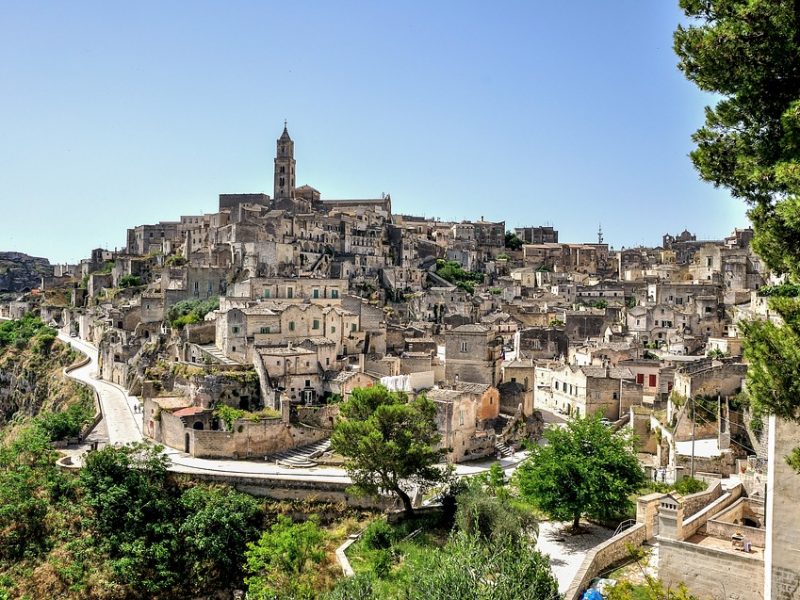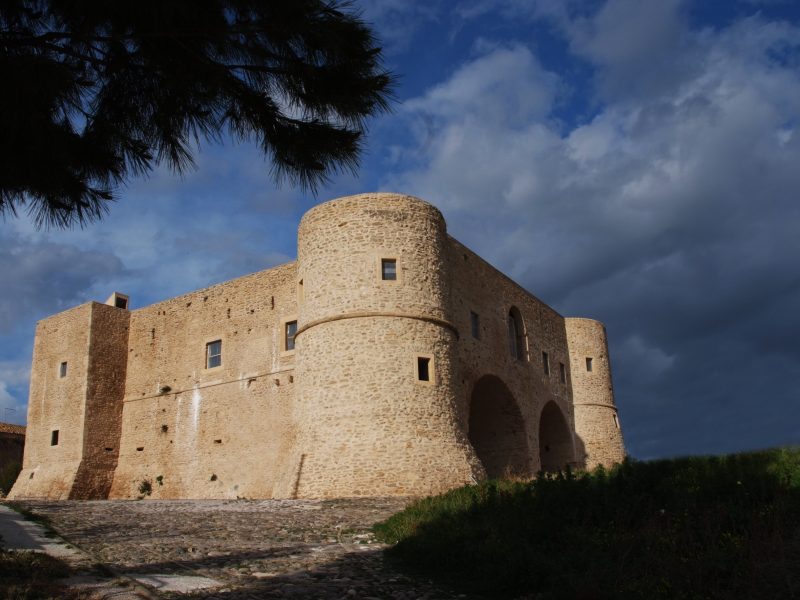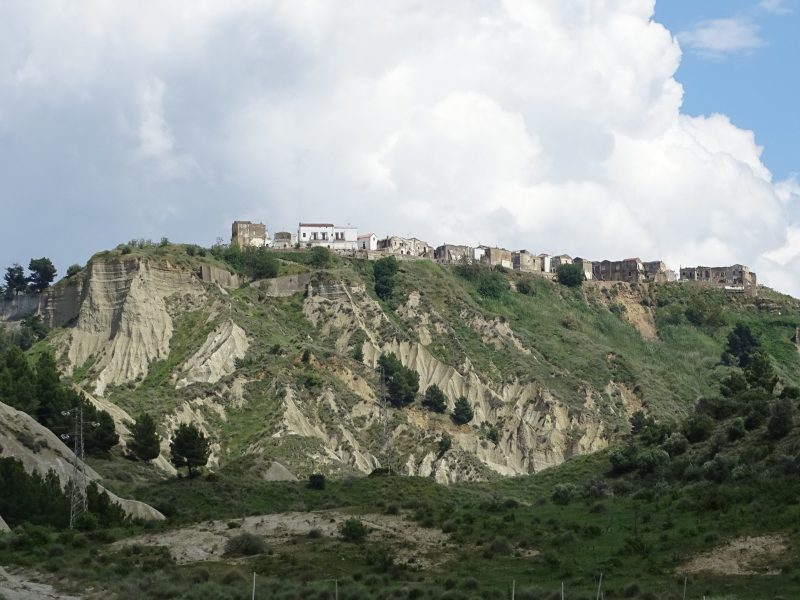The Borgo of Ferrandina
The small white houses of Ferrandina are nestled together as if to protect themselves. In their sober white simplicity, with their roofs the color of the earth, you would never imagine they hide an independent soul that refuses to be tamed.
This village in Basilicata overlooks the valley and the Basimento river from high upon its hill. The countryside is a cross-hatching of shades of green, punctuated by the dark and powerful green of the secular olive trees.
Ferrandina has a rebellious and curious soul that has never submitted to injustice, finding the strength to go forward in the timeless wisdom of her ancient streets. The dome of San Domenico observes the city from above, not far from the tower of the convent of Santa Chiara, which still retains its gruff defensive character even after the threat of invasion no longer looms on the horizon.
Ferrandina lives in a delicate balance between history and legend, as in the nearby village of Uggiano, where the fine clothes of a merchant and the ruins of a castle take part in a legend that expresses the very essence of this place. Ferrandina is a borgo as simple and rustic as its traditional baked olives, and above all, authentic and genuine, as only dreamers know how to be.
Ferrandina’s origins are extremely ancient. Its privileged position has favored human settlements since the Iron Age, evidence of which can be found in the ancient findings in the subterranean areas under the city.
One thousand years before Christ, this place was inhabited by a community from Magna Grecia who named the borgo Troilia, in honor of Troy, the city in Asia Minor destroyed in the legendary war. Not far from Troila, another village was founded, constructed around the castle of Obelanum, now known as Uggiano.
Both these towns were favored by the driving force of Greek culture, and during the Byzantine period underwent considerable development, acquiring a certain importance in the territory. When the dominance of the Byzantine rulers began to weaken, new conquerors arrived in the south of Italy, first the Lombards and then the Normans.
The early chapters of Ferrandina’s history have been recreated thanks to archeological findings and historical evidence discovered in the historical center, but the first written testimony of this borgo dates back to around 1029.
In the 1400’s, a violent earthquake destroyed the villages of the area, and only after the arrival of Frederick of Aragon was a new city founded, with the help of the refugees from nearby Uggiano, who then transferred to the new city. The new borgo was called Ferrandina, probably in honor of the son of King Ferrante I and Frederick of Aragon’s brother, Ferrandino, and who died very young. Frederick of Aragon constructed a defensive system of walls and watch towers, built a castle and laid the foundation stone for the construction of the mother church, dedicated to Santa Maria della Croce.
The 1500’s brought a fresh wind of economic growth to Ferrandina, driven by agriculture, sheep farming and the ever-increasing demand for “Ferlandina”, a high quality fabric produced by the women of the city on their looms.
The largest purchases of Ferlandina were made by the Domenican monks, who decided to settle in Ferrandina, spurring the development of a well organized urban center and the construction of a church dome dedicated to San Domenico.
The dawn of the contemporary age marks the beginning of a long period of social struggle and uprisings for Ferrandina. During the Risorgimento, the city took a liberal stance and actively participated in the revolts of 1821 and 1860. After the Unity of Italy, it was the stage for military clashes between the “briganti” (local rebels) and the forces from Piedmont representing the King. In fact, it was here in Ferrandina that the infamous “brigante” Carmine Crocco succeeded in defeating an entire company of the Savoia army.
The advent of Fascism brought about one of the darkest periods in the history of this town. The population of Ferrandina had never approved of Mussolini’s operations or his regime, which made the town a target for his hit squads, eventually leading to the assassination of the mayor, Nicolo Montefinese.
In 1943, toward the end of the Second World War, the people of Ferrandina rose up once more against Fascism, the protests growing more heated and bitter after the 2nd of August, 1945, when they began forcefully demanding the exile of the Fascist landowners and the restitution of the land they had seized. In the fear that this spirit of rebellion would take root and spread to the nearby towns, Ferrandina was put into lockdown, left for days without electricity, with the telephone lines disconnected.
The situation slowly normalized when the provisional anti-Fascist government sent a garrison of the police to the borgo, followed by a visit from the acting Minister, Scelba.
In 2003, a new spirit of protest ignited the inhabitants of Serrandina, who did not hesitate to take to the streets to demonstrate against the construction of a toxic/nuclear waste collection center in the nearby municipality of Scanzano Jonico.
The Church of Santa Maria della Croce
In 1491, Federick of Aragon laid the foundation stone for the construction of the mother church in Ferrandina, which is all we know about its construction, the rest is lost in the corridors of time.
The church probably stands on the same site as a previous place of worship, probably the ancient mother church of Obelanum, dedicated to San Lorenzo.
The stark façade of the church has almost no decorative elements, graced only by three rose windows and three portals, the central portal flanked by two carved stone columns.
The interior of the church dates back to the 1700’s, but echoes the sumptuous aesthetic of the earlier Baroque style.
In the interior, two colonnades running along the sides of the church divide the space and form three naves, the entablature of the central nave supports barrel arches.
The ceiling is divided by spans, each of which is the shape of elliptical domes with the same motif as the central dome, creating the effect of delicate embroidery in pastel shades.
The central altar is a masterpiece of multi-colored inlaid marble, creating a play of color and light.
Behind the apse, hidden from the eyes of the curious, there is a hand-carved wooden choir, a pipe organ and two statues, also carved in wood, depicting Frederick of Aragon and his wife Isabella del Balzo.
The mother church of Ferrandina holds two great treasures, one inside the other. The first is a stauroteca (an object of worship holding fragments of Christ’s cross) bearing the oldest stamp of the goldsmith’s art in Naples, dating back to the fifteenth century. The second is the holy relic it jealously guards: sacred slivers of wood from the Holy Cross of Christ, to whom the church is dedicated. Every year on the 14th of September, Ferrandina holds celebrations in honor of this holy relic.
The Convent of Santa Chiara and the Museum of Agricultural Civilizations and Ancient Crafts
A square and austere tower surveys Ferrandina, a city that no longer needs protection from external threats, yet that last bastion of defense continues to remain standing. Over time this tower has become the symbol of the Convent of Santa Chiara.
The convent is located in the same place as where a fortress previously stood, maintaining over the centuries a sober simplicity.
Construction began in 1610, an event of great pomp and circumstance, in the presence of the entire clergy of Basilicata. The institution of a monastery had been strongly desired by the noble families of the area, as they wished to have a place to entrust their daughters who had chosen the monastic life.
The monastery does not contain works of particular value, with the exception of a depiction of the crucifixion by Pietro Antonio Ferro, and a painting of the Madonna attributed to Francesco Solimena (1730).
By Napoleonic decree, the convent of Santa Chiara was one of the numerous religious structures to have their religious function abolished, beginning the slow metamorphosis to becoming a cultural center for exhibitions and events.
Since 2015, the halls of the convent of Santa Chiara have hosted the Museum of Agricultural Civilization and Ancient Crafts.
The museum was founded in 2009 with a permanent exhibition, housed inside the building owned by the Trifolgi-Saggese family. The establishment of which had been strongly supported by the whole community of Ferrandina, who wanted to bring their past back to life, in all its rustic simplicity, the recreation of a corner of history to serve as a source of reflection and inspiration for the younger generations.
The large numbers of visitors and the continuous contribution of new artifacts by private individuals gradually made it necessary to move to a larger location, which could also host seminars and workshops.
The museum is divided into three sections. In the first area, we find corners of various traditional activities: a barber shop, a shoe makers workshop, a blacksmith’s workshop, a carpenter’s workshop, and an enormous loom utilized by the townswomen to produce the prized “Ferlandina” fabric.
The second area presents the reconstruction of life in the fields, thanks to the use of a rudimentary plow and the tools used in daily life.
The last innermost section is located in the cellar, its cool temperature perfect for recreating the environment traditionally used for the conservation of food. The figuli, the master craftsmen of Ferrandina’s ceramics and terracotta, have provided a vast collection of traditional objects, mostly jars and vases, used for storing grains and legumes.
In the immense historical patrimony of this museum, there is one especially important piece: a unique and extremely rare representation of the Madonna of the Olives, which is worshiped only in Ferrandina.
The Museum of Agricultural Civilizations and Ancient Crafts is a work in progress in continuous evolution, thanks to the invaluable contribution of the community, the ever curious and attentive custodians of Ferrandina’s traditions.
Uggiano, the Castle and its ruins
A few kilometers from Ferrandina there are some fascinating ruins that attract the curiosity of numerous visitors. One school of thought maintains that the ruins are what remains of the ancient borgo of Obelanum, Uggiano, while others maintain that the location of Uggiano corresponds to the current city of Ferrandina. The debate remains open.
On a hill overlooking the valley, you can admire what could be the ruins of the churches of San Lorenzo, San Domenico and the Abbey of Ognissanti. The urban center was originally built around a castle, of which remain the representative elements of a courtyard, wells and an imposing pointed arch. Descending the slope, you can see the “Plinaccio di Uggiano”, an ancient fountain, and a little further on, the ruins of a tower, probably the last element of the castle, which historical sources believe was destroyed by a heavy rainstorm in 1848.
Little is known about Uggiano, which is likely to have ancient origins. The first testimonies of the borgo date back to the twelfth century. The feudal property passed through the hands of numerous noble families, the last owner being Ferdinand of Aragon, who was ousted by a conspiracy of local barons. A violent earthquake then destroyed Uggiano, and the population took refuge in Ferrandina, which had recently been founded by Frederick of Aragon.
The Church of the Madonna of Mali
The Church of the Madonna of Mali is one of those small and delicate places of worship that struggles against time and the elements to preserve its authentic spirituality, graced by the fragrance of incense and traditional rites. Nature seems to have established a deep bond with this little church, as if neither can do without the other.
This enchanted place immersed in the green of the Matera countryside is far from glories of urban churches, with a simple linearity that is broken only by the bell tower rising behind the façade.
The portal dates back to 1616, and above it you can admire a statue of the Madonna with Child. The interior walls are decorated with frescoes by the Basilicata artist Pietro Antonio Ferro, and the ceiling is completely covered in paintings representing the Madonna and Child and various saints. The central altar is decorated with a painting of the Madonna of Mali.
The Story of the Castle of Uggiano
Once upon a time..
And so every classic fairy tale begins, even though this story is not a fable, fairytale, or even a legend. The story we are about to tell is poised in a delicate balance between truth and fiction.
Once upon a time there was a village and a nobleman, Riccardo da Camarda, who owned a castle, the Ferrazzano or Ferracciano Castle. No one respected this man, because he levied an infinite series of taxes, impoverishing the common people to ensure the pomp and luxury of his court.
One day a merchant passed by, and noticing the beautiful castle and its marvelously tended garden, decided to stop to show the court the beautiful clothes he was selling. The nobleman was enchanted by the elegant fabrics and exquisite embroidery and decided to make a purchase, but when the merchant told him the price, the nobleman was so shocked that he threw him out of the castle, outraged.
Back out on the street, the good merchant decided to give his marvelous creations to the people of the borgo. Once they were dressed in their new clothes, the inhabitants of Ferrazzano began to shine with a rare beauty, and the people of nearby Uggiano competed to marry them. The people of Ferrazzano thus were able to grow in number and became so powerful that they dispossessed the sovereign and destroyed his castle.
Some maintain that the merchant of the story was actually Ferdinand of Aragon, though the dates of the event do not coincide with historical fact.
A less creative and more realistic version of events would be that the inhabitants of Uggiano were faced with a terrible calamity, probably an earthquake, and escaped the village to take refuge in Ferrandina.
Maria Barbella and the Power of Women
Maria Barbella was seventeen years old when she left Ferrandina with her family to emigrate to New York. It was at the end of the 1800’s, and the clashes during the Unification of Italy had plummeted the south of Italy into a dark period, made even worse by a chronic unemployment crisis.
In the hope of a brighter future, many decided to embark on the long journey to the “Americas”, finding their new home in Little Italy in New York, and Maria and her family followed in the footsteps of these brave emigrants
The newly arrived young woman immediately managed to find a job in a cloak factory. Every day on her way to work she passed a shoeshine shop called Domenico Cataldo, and every time she passed by, young Domenico tried to get her attention, but Maria had received a traditional education in the south of Italy. It was important to her to maintain her honor, and the honor of her family, so she limited herself to a brief nod and continued on her way.
One evening Maria decided to reciprocate Domenico’s greeting and she stopped to chat. They discovered that they both came from Basilicata, and began seeing each other. Every evening on her way back from work, she stopped by the shoeshine shop and then Domenico accompanied her home, but he always found an excuse not to meet her parents. The young man knew it would be the first step towards being officially engaged, and then married, but he also knew that he would never be able to marry her, as he had a wife and two children back in Italy.
Maria’s father, fed up with the situation, ordered the girl not to see Domenico again, and she promptly obeyed, even changing her job. Our shoeshine Romeo did not give up however, and he managed to see Maria a few years later, convincing her to recommence their relationship.
The girl was so swept away by the situation that she even conceded her virginity, and the couple decided to set up house together. Nonetheless, marriage remained a distant mirage for Maria, while the daily arguments were a harsh reality.
One day, Maria decided to go with her mother to the shoeshine shop to confront Domenico together. Her mother even fell to her knees to implore the man to marry her daughter, because her father had banished her from the house. The young man, who was engrossed in a game of cards, merely laughed sarcastically. First, he used the excuse that Maria didn’t have a proper wedding dress, but she responded that she was ready to get married in the clothes she was wearing. Then, Domenico asked to be paid 200 dollars in exchange for the marriage, but her mother retorted that they were a poor family and had no way to pay such a high sum.
At that, Mr. Shoeshine laughed again, saying with derision “Only pig marry”- only a pig would marry you. Blinded by rage, Maria swept off her mantle, took out the razor she was carrying, and cut his throat.
The girl was arrested immediately and taken to the prison of Le Tombs, where the story caught the attention of Rebecca Salomè Forrester, the widow of General Forrester, who worked as a volunteer in the prison, offering assistance to inmates. Despite the woman’s influential power, even she was not able to halt the American justice system.
On the 11th of June, 1895, the trial against Maria Barbello began. No Italians were present, the girl paid a high price indeed for having emigrated. Inadequate knowledge of the language, both on her part and the interpreters, did not allow her to make plausible statements in her defense. Five days later, the trial ended with the death sentence, the first ever to be levied on a woman.
The case touched the heart of Cora Slocomb of Brazza, an American countess who had moved to Italy for love. She believed in the ideals of justice and equality, and was convinced that Maria was only a scapegoat in a country with serious problems regarding integration and racial discrimination.
Cora decided to leave for New York with her husband, where they were able to mobilize the most important and influential social factions in America, putting together an extremely powerful campaign in Maria’s favor. Free of charge, the three most important lawyers in the city offered their services and were able to reopen the case. A new trial began that lasted twenty four days, concluding in Maria Barbello’s full acquittal.
A few years later, Maria was finally able to begin the family she had so dearly wanted, marrying an Italian immigrant, with whom she had a son.
The story of this girl from Basilicata was told by Cora Slocomb’s great grand-daughter, Idonna Pucci, who published the novel “The Fire of the Soul” in 1993. In 2002, the novel was revised and published in Florence by the Giunti publishing house with the title “ The Lady of Sing Sing. No to the Death Penalty”. In 2005, the Sant’Egido Community awarded Maria’s birthplace, Ferrandina, with the title “City for Life”, in solidarity against the death penalty.
______________________________________
Do you known of any famous people related to this borgo? Contact us!
Baked Olives
The countryside surrounding Ferrandina is characterized by the thick green foliage of olive trees. A particular variety of olive is cultivated in this area, called Majatica, used for the production of oil, and especially for the production of baked olives, a traditional recipe found in this village in Basilicata.
The olives are immersed for a few minutes in water heated to 90°, in order to be lightly seared, and then are placed in salt until they are partially dried. After this first step, the olives are placed in a drying machine at 50°. The original recipe, dating back to the 1700’s, required that the olives were dried in a wood oven, but at the beginning of the 1900’s the people of Ferrandina opted for new technologies that have nevertheless retained the original quality, distinguished by a flavorful natural sweetness.
The baked olives of Ferrandina can be enjoyed in many ways, either in their original simple form or seasoned with extra virgin olive oil, garlic and orange and lemon peels. They make a wonderful compliment to cured meats and aged pecorino cheese, and are also used for the preparation of yellow squash soup and stewed codfish.
These unique baked olives are a mainstay in the history of Ferrandina. Because of their traditional authenticity they are considered a local heritage, and are protected by the Slow Food Presidium.
_________________________________
Do you known other typical recipes related to this borgo? Contact us!

 Italiano
Italiano
 Deutsch
Deutsch

